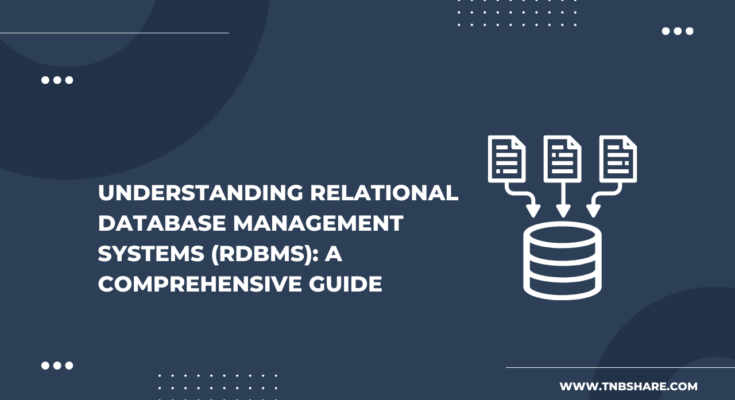Contents
Introduction
Businesses and organizations must effectively manage and organize massive amounts of information in today’s data-driven environment. Relational Database Management Systems (RDBMS), which provide dependable, adaptable, and scalable solutions for a broad range of applications, have emerged as the industry standard for managing structured data.
With the use of Structured Query Language (SQL), an RDBMS organizes data into tables made up of rows and columns, enabling sophisticated data manipulation and querying. Informed decision-making is facilitated by this methodical approach, which also reduces redundancy and guarantees data integrity. It also makes it possible to use strong data links and insights. We will examine the core ideas, benefits, and drawbacks of RDBMS in this post to provide readers with a thorough grasp of this essential technology.
What is RDBMS?
RDBMS organizes data into tables, each of which contains rows and columns. The columns, or characteristics, specify the data fields within each record, while the rows, or records, represent individual data entries. A company’s database might have a customer table with columns like Company ID, Company Name, Company Address, and Company Primary Phone, where each entry corresponds to a distinct customer.
Linking Tables with Common Data
The capability of RDBMSs to join tables based on shared data fields is one of its primary characteristics. Think of a business that keeps transaction and customer tables. Columns like Transaction Date, Customer ID, Transaction Amount, and Payment Method may be present in the transaction table. The Customer ID column facilitates the creation of comprehensive reports, including customer statements that aggregate all transactions within a given timeframe, by acting as a common link between the transaction and customer tables.
SQL: Language for RDBMS
The industry standard language for organizing and querying data in relational databases is called Structured Query Language, or SQL. Millions of records could be processed efficiently with SQL, facilitating rapid data retrieval and sophisticated query execution.
Advantages of RDBMS
Flexibility
RDBMSs provide data management flexibility. While the database is operating, you can use SQL to add new columns, construct new tables, rename relations, and perform other changes. This dynamic flexibility is essential for changing data requirements.
Reduced Redundancy
By design, RDBMS reduces data redundancy. For instance, a client’s information is only kept once in the customer table. This table is referenced by customer-related transaction data, which removes the need to repeat customer information in many tables.
Easy Backup and Disaster Recovery
Relational databases make backup and restoration procedures simple by offering simple export and import options. Continuous mirroring is frequently supported by cloud-based relational databases, cutting down on data loss during recovery to a matter of seconds.
ACID Compliance
Atomicity, Consistency, Isolation, and Durability, or ACID compliance, is how RDBMSs guarantee data accuracy and consistency. Even in the case of failures, this compliance ensures dependable database transaction processing.
Popular RDBMS Solutions
RDBMS solutions are offered in a variety of sizes, from compact desktop systems to large cloud-based systems. Several well-known RDBMSs are:
- IBM DB2
- Microsoft SQL Server
- MySQL
- Oracle Database
- PostgreSQL
Database-as-a-Service (DBaaS), another name for cloud-based RDBMS, makes use of the enormous processing and storage resources of the cloud. Amazon RDS, Google Cloud SQL, IBM DB2 on Cloud, Oracle Cloud, and SQL Azure are a few notable examples.
Use Cases for RDBMS
Online Transaction Processing (OLTP)
Relational databases offer multiple users and frequent queries with quick response times, making them perfect for OLTP applications that demand high transaction rates.
Data Warehouse
RDBMS can be configured for Online Analytical Processing (OLAP) in data warehousing systems, which makes it possible to analyze historical data for business intelligence.
IoT Solutions
RDBMSs are advantageous for Internet of Things (IoT) applications because they can swiftly gather and handle data from edge devices, providing a portable yet reliable database solution.
Limitations of RDBMS
- Limited Scalability for Big Data
- Complex Scheme Migration
- Fixed Scheme
- Performance Overhead with Join Operations
- Data Length constraints
Even with all of their benefits, relational database management systems (RDBMS) are not ideal for handling semi-structured and unstructured data, which limits their application in comprehensive analytics on such data. Furthermore, data must have the same schemas and data types when transferring data between RDBMS, and data field length requirements apply.
Also read: Understanding Data Repositories: Data Warehouses, Data Marts, and Data Lakes
Conclusion
Despite the difficulties presented by big data, cloud computing, IoT devices, and social media, relational databases continue to be the most widely used technology for managing structured data. They are still relevant and useful in a variety of applications because of their adaptability, effectiveness, and strong data management skills.
Organizations can use structured data to obtain important insights and make wise decisions by grasping the benefits and guiding principles of relational database management systems. Modern cloud-based solutions or more conventional on-premises systems, RDBMS provides a stable and mature framework for data management.
Reference and Resources:
That’s it guys, if you’ve learned something from this article, do share.




